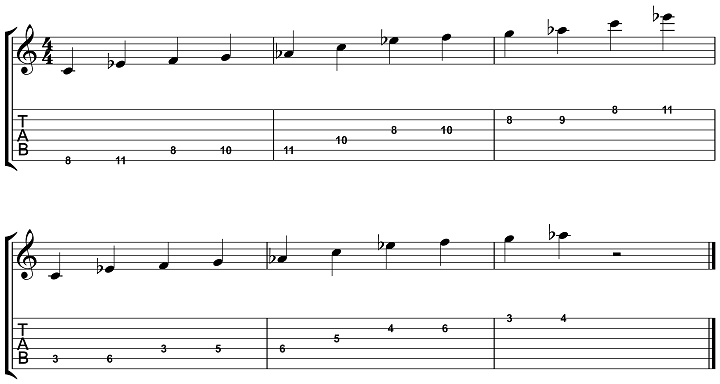Printable Version of Topic
Click here to view this topic in its original format
GMC Forum _ THEORY _ What Are Aeolian Pentatonic Scales
Posted by: The Professor Jun 5 2013, 11:24 AM
What Are Aeolian Pentatonic Scales
Though many of us learn and use the Minor Pentatonic Scale in our soloing, we tend to stop there when it comes to exploring minor sounds in our pentatonic scales. While the minor pentatonic scale can cover a lot of ground, sometimes we want to zoom in on a specific modal sound, such as a Natural Minor chord or other tonality, and this is where the other minor-sounding pentatonic scales come into play.
In this lesson, we’ll take a look at the theory behind the Aeolian Pentatonic Scale, how it is built, how to apply it to your soloing and a few common fingerings that you can explore in the practice room.
How to Build an Aeolian Pentatonic Scale
The Aeolian Pentatonic Scale is built from the following interval pattern.
Root - b3 - 4 - 5 - b6
Notice that this is only 1 note different from the Minor Pentatonic Scale, the b7 has been flattened by a tone to a b6.
This will help you learn this scale as you can take any Minor Pentatonic Scale shape you know, lower the 7th note by 2 frets and you will have created an Aeolian Pentatonic Scale shape.
You can see these notes laid out in tab and notation for a C Aeolian Pentatonic Scale here.

You can also think of the Aeolian Pentatonic Scale as being a fragment of the corresponding Aeolian Scale.
If you have a C Aeolian Scale, C D Eb F G Ab Bb C, and you take out the 1st, 3rd, 4th, 5th and 6th notes, C Eb F G Ab, you now have an Aeolian Pentatonic Scale.
To apply this scale in a soloing situation, you can use the Aeolian Pentatonic Scale over just about any minor-sounding chord, depending on style, and it will work to varying degrees of success.
It works over Minor chords, as well as m7, mb6, m9 and m11 chords, which is why it can be used over a variety of progressions when using this scale to build solos on the guitar.
2 Common Aeolian Pentatonic Scale Fingerings
To help get you started, here are two common fingerings for the C Aeolian Pentatonic Scale, one with a 6-string root, and one with a 5-string root.
Try memorizing these Aeolian Pentatonic scales in the key of C first, then take them to the other 11 keys around the neck as you expand on these scale shapes in your guitar practice routine.

Aeolian Pentatonic Scale Practice Guide
To finish up, here are a number of ways that you can practice Aeolian Pentatonic scales in order to get the fingerings, and theory, behind these scales under your fingers and into your guitar playing.
1. Sing the root note, C for example, and play the corresponding Aeolian Pentatonic Scales over that root.
2. Play a root note on the guitar, C for example, and then sing the corresponding Aeolian Pentatonic Scale over that root note.
3. Say the note names, or interval numbers, such as C Eb F G Ab or 1 b3 4 5 b6, as you play and sing the notes in the above exercises.
4. Put on a static vamp, Cm, Cmb6, Cm7, Cm9 or Cm11 for example, and practice soloing over those chords using the related Aeolian Pentatonic Scale as the basis for your solo.
5. Repeat any/all of the above exercises in all 12 keys.
Do you have a question or comment about Aeolian Pentatonic Scales? If so, share them in the comments section below this thread.

Powered by Invision Power Board (http://www.invisionboard.com)
© Invision Power Services (http://www.invisionpower.com)